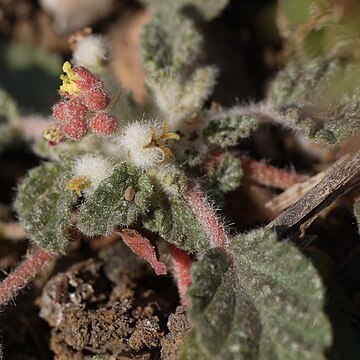A prostrate, decumbent or ± erect, branched annual or perennial herb up to c. 50 cm high. Stems yellowish or pinkish. Petioles 1-7 cm long. Leaf blades 1.5-7 x 1-5.5 cm, broadly ovate to rhombic-ovate, sometimes shallowly 3-lobed, obtuse or rounded at the apex, asymmetrically cuneate, truncate or shallowly cordate at the base, plicate-undulate at first, later ± flat and shallowly repand-dentate or ± entire on the margin, thinly chartaceous, with 2 discoid dark purple glands at the base, 3-5-nerved from the base; leaf upper surface at first incubously bullate, later ± flat; lateral nerves in 2-3 pairs, tertiary nerves arachnoid, scarcely prominent on both surfaces. Stipules 1-2 mm long, subulate. Inflorescences 1.5-3.5 cm long; bracts resembling the stipules. Male flowers: pedicels c. 1 mm long; calyx lobes 3 x 1 mm, lanceolate, acute, stellate-pubescent without, glabrous within; petals 3 x 1 mm, elliptic-oblong, ± obtuse, lepidote without, glabrous within, yellowish-orange or pinkish; disk c. 1 mm in diameter; staminal column 4 mm high, anthers 15 in (2)3 series, 1 mm long. Female flowers: pedicels 3-7 mm long, extending to 1.5-2 cm in fruit; sepals 1.5-2 x 0.5 mm, linear-lanceolate, acute, stellate-pubescent without, simply puberulous within; petals minute or absent; disk more or less as in the male flowers; ovary 2 x 2 mm, 3-lobed, densely stellate-pubescent; styles 1.5-2 mm long, abaxially stellate-pubescent, adaxially coarsely-papillose, crimson. Fruit 4-5 x 7-9 mm, strongly 3-lobed, densely stellate-pubescent, green at first, later reddish-or bluish-purple. Seeds 3.5 x 3 mm, minutely tuberculate-rugulose or ± smooth; sarcotesta papery when dry, pale grey; sclerotesta dark brownish or blackish.
Leaf blades 1.5–7 × 1–5.5 cm, broadly ovate to rhombic-ovate, sometimes shallowly 3-lobed, obtuse or rounded at the apex, asymmetrically cuneate, truncate or shallowly cordate at the base, plicate-undulate at first, later ± flat and shallowly repand-dentate or ± entire on the margin, thinly chartaceous, with 2 discoid dark purple glands at the base, 3–5-nerved from the base; leaf upper surface at first incubously bullate, later ± flat; lateral nerves in 2–3 pairs, tertiary nerves arachnoid, scarcely prominent on both surfaces.
An annual herb. It can lie along the ground or curve upwards. It grows 50 cm high. It has white or grey hairs. The leaves are triangle shaped and 1-4 cm long by 1-3 cm wide. The flowers are opposite the leaves. Male and female flowers are separate. Male flowers are orange-yellow and female flowers are red. The fruit have 3 lobes and are 5 mm long by 9 mm wide. They are reddish-purple when ripe.
Female flowers: pedicels 3–7 mm long, extending to 1.5–2 cm in fruit; sepals 1.5–2 × 0.5 mm, linear-lanceolate, acute, stellate-pubescent without, simply puberulous within; petals minute or absent; disk more or less as in the male flowers; ovary 2 × 2 mm, 3-lobed, densely stellate-pubescent; styles 1.5–2 mm long, abaxially stellate-pubescent, adaxially coarsely-papillose, crimson.
Male flowers: pedicels c. 1 mm long; calyx lobes 3 × 1 mm, lanceolate, acute, stellate-pubescent without, glabrous within; petals 3 × 1 mm, elliptic-oblong, ± obtuse, lepidote without, glabrous within, yellowish-orange or pinkish; disk c. 1 mm in diameter; staminal column 4 mm high, anthers 15 in (2)3 series, 1 mm long.
Seeds 3.5 × 3 mm, minutely tuberculate-rugulose or ± smooth; sarcotesta papery when dry, pale grey; sclerotesta dark brownish or blackish.
Fruit 4–5 × 7–9 mm, strongly 3-lobed, densely stellate-pubescent, green at first, later reddish-or bluish-purple.
A prostrate, decumbent or ± erect, branched annual or perennial herb up to c. 50 cm high.
Inflorescences 1.5–3.5 cm long; bracts resembling the stipules.
Stipules 1–2 mm long, subulate.
Stems yellowish or pinkish.
Petioles 1–7 cm long.

